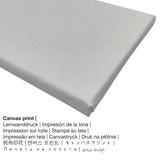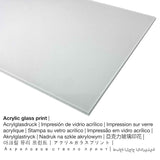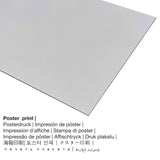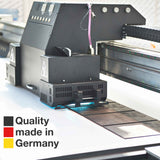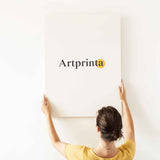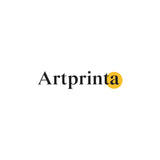Aert Schouman, 1720 - Ọmụmụ ihe abụọ nke oke ọkpa nwụrụ anwụ - mbipụta nka mara mma
Ụtụ gụnyere. Mbupu gbakọrọ na ndenye ọpụpụ.
Họrọ ihe ị họọrọ
The product dropdown menu ofers you the chance to pick your prefered size and material. We allow you to pick your favorite size and material among the following product individualization options:
- Mbipụta aluminom (aluminium dibbond): An Aluminium Dibond print is a print material with an impressive effect of depth. A non-reflective surface make a contemporary look. A direct Direct Print on Aluminum Dibond is the ideal start to fine art replicas produced on aluminum. The bright and white sections of the original artpiece shine with a silky gloss, however without glare. The colors of the print are luminous in the highest definition, the details of the print appear crisp and clear.
- Mpempe akwụkwọ mmado ebipụtara na akwa akwa: The poster is a UV printed sheet of canvas paper with a slight surface texture, which resembles the actual artwork. The poster print is ideally appropriate for placing the art replica in a personal frame. Please note, that depending on the size of the poster we add a white margin of around 2 - 6cm round about the work of art in order to facilitate the framing with your custom frame.
- Mbipụta kanvas: A canvas print is a printed canvas stretched on a wooden stretcher. In addition to that, a canvas generates a cosy, pleasing look. A canvas of your favorite artpiece will allow you to transform your custom art print into a large work of art. Canvas Prints have the great advantage of being relatively low in weight, meaning that it is quite simple to hang up the Canvas print without the help of extra wall-mounts. Canvas prints are suitable for all types of walls.
- Mbipụta iko acrylic na-egbuke egbuke (nke nwere ezigbo mkpuchi iko): A glossy print on acrylic glass, often referenced as a UV print on plexiglass, will convert an original into beautiful décor and makes a viable alternative to canvas and aluminidum dibond prints. Your own replica of the work of art will be manufactured with the help of modern UV direct print technology. The great benefit of an acrylic glass print is that contrasts and also smaller artwork details become exposed because of the fine gradation.
Ederede iwu: We try our utmost in order to describe our art products as accurate as possible and to illustrate them visually. Nonetheless, the colors of the print products and the printing might differ slightly from the representation on your device's screen. Depending on the screen settings and the nature of the surface, not all color pigments will be printed one hundret percent realistically. Considering that our fine art prints are processed and printed by hand, there might as well be minor differences in the size and exact position of the motif.
Nkọwapụta ngwaahịa nka
In 1720 the artist Aert Schouman painted this baroque painting "Two studies of a dead rooster". N'ịga n'ihu, agụnyere ihe osise a n'ime Rijksmuseum's mkpokọta dị na Amsterdam, Netherlands. We are pleased to reference that the masterpiece, which is in the ngalaba ọha a na-enye ya site n'ikike nke Rijksmuseum.Akụkọ nke ọrụ nka bụ ihe ndị a: . Ọzọkwa, nhazi nke mmepụta dijitalụ dị n'ime odida obodo format ma nwee oke nke 16: 9, nke pụtara na ogologo bụ 78% ogologo karịa obosara. The engraver, painter, etcher, watercolourist Aert Schouman was an artist from the Netherlands, whose art style was primarily Baroque. The Baroque painter lived for a total of 82 afọ a mụrụ ya n'afọ 1710 ma nwụọ na 1792.
Data nka ahaziri
| Aha eserese: | "Two studies of a dead rooster" |
| Nhazi nka: | sere |
| Otu sara mbara: | nka ochie |
| Time: | 18th narị afọ |
| Emepụtara na: | 1720 |
| Afọ nka: | ihe dị ka afọ 300 |
| Ụlọ ihe ngosi nka / mkpokọta: | Rijksmuseum |
| Ebe ebe ngosi nka: | Amsterdam, Netherlands |
| Ebe nrụọrụ weebụ ihe ngosi nka: | Rijksmuseum |
| Licensedị ikike: | ngalaba ọha |
| Site n'aka: | Rijksmuseum |
Nkọwa ngwaahịa
| Ụdị edemede: | nka nka |
| Usoro mmeputakwa: | mmeputakwa n'ụdị dijitalụ |
| Usoro mmepụta: | mbipụta dijitalụ (Mbipụta UV ozugbo) |
| Ihe ngosi: | German mmepụta |
| Ụdị ngwaahịa: | na mmepụta ihe |
| Ihe eji eme atụmatụ: | nchịkọta nka (mmeputakwa), ihe ndozi ụlọ |
| Nhazi nke ihe nka: | usoro odida obodo |
| Ụdị anya: | 16:9- (ogologo: obosara) |
| Nkọwa: | ogologo bụ 78% ogologo karịa obosara |
| Nhọrọ dị: | Mbipụta kwaaji, mbipụta enyo acrylic (nwere ezigbo mkpuchi iko), mbipụta ọla (aluminium dibond), mbipụta akwụkwọ mmado (akwụkwọ kwaaji) |
| Canvas dị n'elu ihe nrịbama (mbipụta kanvas) nha dị iche iche: | 90x50cm - 35x20" |
| Mpempe iko acrylic (nwere ezigbo mkpuchi iko) nha: | 90x50cm - 35x20" |
| Nhọrọ nha nke akwụkwọ mmado (akwụkwọ kwaaji): | 90x50cm - 35x20" |
| Aluminom dibond ọdịdị nha ebipụta: | 90x50cm - 35x20" |
| Nhazi mbipụta nka: | agunyeghi |
Tebụl onye na-ese ihe
| Aha onye nka: | Aert Schouman |
| Aha utu aha: | Schouman, Scoumant, Shouman, Schouman Aernout, Aert van Schouman, Scouman, Schouman Aart, Aart Schouman, Schouman Aert, Aert Schouman, A. Schouman, Sckouman |
| okike nke onye nka: | nwoke |
| Obodo onye nka: | Dutch |
| Ọrụ nke onye na-ese ihe: | painter, watercolourist, etcher, engraver |
| Country: | mba netherland |
| Otu nka: | nna ukwu ochie |
| Ụdị nka: | Baroque |
| Akwụsị: | 82 afọ |
| Afọ amụrụ: | 1710 |
| Afọ ọnwụ: | 1792 |
© Nwebiisinka nke, Artprinta.com


